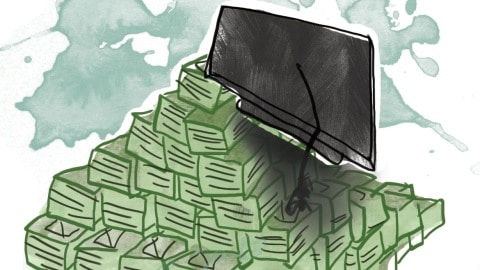COURTNEY BOWMAN
 While the average university classroom would indicate that education is a basic right, there appears to be a disconnect between what Saskatchewanians believe in and what they are being provided.
While the average university classroom would indicate that education is a basic right, there appears to be a disconnect between what Saskatchewanians believe in and what they are being provided.
The Saskatchewan government’s system of financial support for post-secondary education is failing many of its recipients.
We’ve all heard horror stories of “average” and low-income students who — after receiving their scant student loans — find that they’re barely able or unable to keep their heads above water financially. This usually ends up affecting them academically, as they’re expected to work a part-time job to pull in supplementary income. Thankfully, cheap food can keep them from starving, though the nutritional benefits of a SPAM and Kraft Dinner-based diet are negligible.
The provincial government has implemented a Graduate Retention Program which “rewards” post-secondary graduates for staying in Saskatchewan after completing their education with a maximum tax rebate of $20,000 paid over seven years. In an article written for the Globe and Mail last August, Alex Usher, president of Higher Strategy Education Associates, wrote that post-secondary education in Saskatchewan is practically free because of this program.
Take this with a grain of salt — HSEA is a consultation-communications company that helps educational institutions streamline their program offerings and make themselves more attractive to students through a “crafted narrative” of branding and strategy. Interestingly, they count the University of Saskatchewan as one of their clients.
However, Usher’s praise overlooks a few gaps: those who have moved beyond completing their first degree or who leave Saskatchewan after finishing their degree are not compensated and the chosen academic program must also be recognized by the provincial government.
In another article featured in the Globe and Mail last month, Erika Shaker, head of the Canadian Centre for Policy Alternatives — an independent non-partisan research institute — presented an opposing position.
“The public investment in post-secondary education is sadly declining […] the individual contribution is increasing. All the evidence both in Canada and the U.S. does indicate that financial stressors on students are even more pronounced than stressing about academic performance.”
This leaves universities in a precarious position as they are faced with a loss of operating revenue as direct funding from the provincial government decreases, but are unable to speak out due to fear of the consequences of biting the hand that feeds them.
Meanwhile, the provincial government continues to put a positive spin on the limited amount of support that post-secondary institutions receive, promoting their Graduate Retention Program as well as various scholarship and grant opportunities. In a press release dated for early September of this year, the Sask Party reported that thousands of students benefited from what they’ve termed “student investment.”
Yet, thousands of young adults will graduate this year from the U of S and other post-secondary institutions in Saskatchewan with an average debt load of $27,000, according to the Canadian Federation of Students, due to a lack of direct provincial funding from said institutions. For young adults with no assets and no financial security, a debt this large can be a massive burden, delaying typical adult milestones such as getting married, having children or owning property — even moving out of mom and dad’s basement — and adding numerous psychological strains.
The only provinces that prove an exception to this in Canada are Quebec and Newfoundland, which have the lowest tuition rates in the country. This is a result of their respective provincial governments placing a higher priority on the value of post-secondary education. As it relates to our provincial government under the Sask Party, our university now has some of the highest tuition rates in Canada with an increase of four per cent for Arts and Science students in the 2014–15 academic year, an overall average increase of 4.5 per cent in 2013–14 and an overall average increase of 4.75 per cent in 2012–13.
In contrast, just prior to their defeat in the provincial election in 2007, the NDP released a report on higher education in which cutting tuition fees by $1,000 was a key election promise. As well, they had frozen tuition fees at both the University of Regina and the U of S since 2005 and had planned to continue to until at least 2008. If they had won the election, tuition fees would have been the fourth lowest in Canada at the time.
So what does this mean for students today? Simply put, the Sask Party, with 64 per cent of the popular vote in the 2011 election, is not hard pressed to improve their track record for post-secondary funding. Rather, it looks as though the situation will continue to worsen with scheduled tuition increases until 2016.
While defunding education serves to increase the gap between rich and poor in Saskatchewan and enhance other socioeconomic stressors, education that is truly affordable and accessible would serve to reduce poverty. Shouldn’t all residents of the province be entitled to share in “have” status equally? Lack of access to funding for education proves that while all residents should be, in practice, they are not.
—
Graphic: Stephanie Mah/Graphics Editor